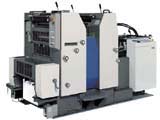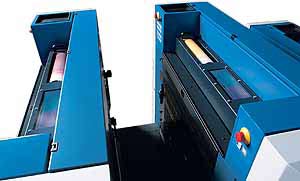Printing Press Contracts

Price | Service | Terms and Conditions
One of the most critical elements to purchasing a machine is the contract. What you need to keep in mind is that a company that sells printing presses has gone through this process many, many times. The average printer purchases a new press once every seven years. It’s a total mis-match.
Every transaction, no matter how big or small, will have three elements to it. They are all intertwined and cannot be separated.
- 1. Price; The amount the buyer agrees to give the seller.
- 2. Service; This is the element that encompasses everything the seller says he is going to do. A few examples are;
- Purchasing a Used Press, Delivery, Installation, Print, Testing, Training and Warranty.
There could well be no service at, as in a “as is, where is” deal. The point will be to define exactly what the services will be. Every bit of service put on the seller, relieves you of that responsibility, and all that could wrong with that portion of the deal.
- 3. Terms and Conditions;
- This is how the transaction will occur. When will the money be exchanged for the goods.
The above is presented in the order that most people think about. However, they are presented in exactly the opposite order you should think about them. Terms and conditions can be called the “The Golden Rule”. What that means is he who holds the gold, makes the rules. The more of the gold you can hang on to as the deal progresses, the more you get to influence the rules.
Lets review the importance of each;
Price;
This is the one everyone focuses on. In fact, this is to your detriment. Successful magicians always use a tried and true tactic; getting you to focus on one hand, while the cards are being switched in another. It’s a classic technique; distract the person so they won’t focus on other things. Generally speaking price is the easiest thing for the seller to manipulate.
Side note on Price;
- Trade ins;
Many sellers of printing presses will ask you if you have a trade in, prior to telling you the asking price of a machine for sale. This is because they know you will want the most for yours, and want to pay them the least for theirs. Thus they inflate the selling price, in order for it to appear that you are getting what you want for your trade in. In fairness to most sellers, people invariable want way too much for their trade in. Sellers cannot pay much more to you than wholesale, as they only make money buying at wholesale, and selling at retail. However, you want to bring the issue of the trade in up later in the game.
Service;
This element is very important. It represents so much of what you are going to get and even more, the responsibilities a seller will have. Here is where the price thing distracts so many buyers. Often to get the price down a buyer will start shedding service features, or many buyers get the idea they can save a lot of money by buying a machine and then organizing the delivery and installation themselves. Some even go off to Europe in search of a great deal. There is nothing wrong with this approach, but the risk factor sky rockets. For example, if you bought a machine direct from a printer you would now be faced with the rigging, trucking, installation, ect. You get quotes for all of that add it up, plus the cost of the machine and figure you can save $100,000.00. It sounds great.
However, place that $100,000.00 up against a contract that says the seller will be responsible for all of that. It’s not just the money, because all of those quotes represent a best case scenario. It will always come back to a question of who is responsible. The more service involved in the contract, the more they are responsible for. They HAVE to make it happen. The seller becomes in essence, your partner in the deal. He must execute.
Another way to think of it is if the seller is responsible for the rigging, he will be more careful when scheduling the delivery. It’s human nature that if you will suffer the financial consequences, you will do a better job in preparation. It’s not just the money. If the rigging job cost $5,000.00 you would be better of paying $5,000.00 more for the machine and making the seller responsible for all of that scheduling.
Another example, what if the machine is all apart, the riggers are standing there hanging around and you get a call that the trucks are going to be delayed a day. If you scheduled the trucks now it’s your problem, you absorb the cost. If that service is provided in the contract, it’s their problem.
This is where price can be the distraction.
When focusing on the contract it is imperative to decide to what degree is the seller responsible. Many contracts will call for a “warranty”. The first question to ask yourself is; warranted to do what? Common contracts call for a, “print and register warranty”, that’s like saying the car will, “drive down the road”. Print and register at what speed, on what kind of stock, at what resolution, ect?
Ideally you would like to conduct a standard print test on a machine prior to moving it, and then recreate that print test once the seller has the machine up and running. Often this is not possible. However, you want to have a defined process, in the contract, describing what this machine is supposed to do in order to relieve the seller of his responsibilities. For example, he will not want to test the press on light stock because that is more challenging. It exposes the registration, primarily the condition of the grippers.
Another grey area to be aware of is a situation where the press does print but you have parts of the machine that are not right. For example, you can print perfectly fine with a machine that does not have a functioning dryer.
A good way to view this is that someone who is experienced at selling used machines will want a contract. That is because they are the ones who wrote it, they are intimately familiar with all its nuances, and most importantly they will use it to protect themselves. Invariably if problems arise, they know right where to go in that contract to find a provision that protects them.
- READ the contract. Most people that buy machines do not, in fact, read the contract. Furthermore the ones that do, don’t see what is in it. They only see what they are looking for, and most often it’s the price. It’s a lot like the old visual trick where someone shows you a drawing of the old witch, and asks you to find the pretty girl. You don’t see her, despite the fact the drawing is of a pretty girl, because you are pre-disposed to viewing the witch.
- Warranty is not the same as guarantee
- Just about every machine will print. Define how well it will print
- If the machine does not function properly, and you have a thirty day warranty, what happens if the seller is in there with a mechanic for 30 days trying to get it to run properly? With most contracts, on that 30 th day, the warranty is up.
- Have the contract itemize;
Transformers
Air compressors
Refrigeration Tanks (what kind & how many)
Plate Punch, (if included)
Plate Bender, (if included)
Wash up trays, (used presses are notorious for missing some)
Tools
Hickey pickers
Maunuals
Terms and Conditions
This is above all the most important element of the contract. It is also where buyers fail the most. Price, and then the execution of service, will all depend on the terms and conditions. For example, lets say you had an agreement to buy a machine for $100,000.00 and paid $95,000.00 up front, and $5,000.00 after the machine is delivered, installed and up and printing.
What this means is that in reality your ability to convince the seller that he should meet his responsibilities is $5,000.00.
Now take that same contract and make the last payment $10,000.00. Now you have doubled your ability to motivate that seller to finish up the job in strong fashion.
Now lets look at the other end of it, the beginning. It would be better to dole out the payments as the machine gets closer to you. A good standard contract calls for some balance on the payments. A common contract calls for something along the lines of;
5% upon signing the contract
45 % due prior to shipment
45 % due upon delivery of the equipment to buyers dock
5 % due upon installation
This distribution of funds looks pretty fair and spread out.
That seems simple enough. However, there are subtleties here than have some big ramifications. For instance, the first 45% payment is stated to be due, “Prior to shipment”. The reality of that contract means that the seller will now have 50% of your money before the machine has moved one inch inside his building.
Continuing on with this contract, the seller has 50% of your money and the machine is now on its way to your plant, on trucks that the seller controls because he hired them. The next 45% is now due, “upon delivery of the equipment to buyers dock”. This means you owe another 45% before the machine will be brought into your building. Thus, if you adhere, to the contract you signed, the seller now has 95% of your money before you ever come close to taking any sort of control of the machine.
If you make some slight changes to that contract such as;
5% upon signing the contract
40 % due when machine is loaded onto trucks at seller’s plant
40 % due upon machine being placed in buyers building
15 % due upon completion of installation, successful GAF # 4 print test, on 60lb weight paper, at 8,000 SPH, running 25,000 consecutive sheets without tripping
Now the machine is on trucks with only 5% of your money laid out. You have now skipped over the risk of a botched rigging job by the seller. If you have ever seen a 40” machine loaded on a truck, you will feel a lot better knowing you only own 5% of it, than 50%.
When the machine arrives at your plant, and you adhere to this scenario, the machine is now in your building and you have only laid out 50% of the money. That’s a big difference from laying out 95% of the money, and it’s still sitting in your parking lot. Now the installation is defined, the contract states the machine has to print and pass a test. “Installation” doesn’t mean a thing. Printing performance and regular production are why you bought the press.
Another element to payment streams is the distinct possibility that the seller does not actually own the machine. In fact, he is going to take your money and go purchase it in order to sell it to you. You can pick this off by carefully reading the contract.
If the machine is running in another plant somewhere and the contract calls for x amount of payment; “prior to disassembly”, and then another payment “prior to loading” the key term here is prior. If you see the word upon used through out this process then most likely the seller does in fact own the machine. What is often happening when you see the word prior, is that the seller has a contract with the person they are buying the machine from that reads upon. You pay prior to, he pays upon. In the industry it’s called the statue of liberty play. This is roughly what the contracts would look like;
Your Contract with Seller Sellers Contract with Machine Owner
5% deposit upon signing contract 5% deposit upon signing contract
45% prior to disassembly 45% upon disassembly
45% prior to loading 45% upon loading
5% upon delivery 5% upon delivery
Now you will not be able to see the contract the person you are buying the machine from has with the actual machine owner. However, if you are buying a machine from a press dealer, and that machine is in a plant somewhere, and your contract reads “prior” in each fund line item, most likely they are using your money to buy the machine in the first place.
This is risky business and you would be surprised how common it is. What if the plant is suddenly declared bankrupt and the judge throws a lock on it. Where’s your money now.
This scenario is also very common when buying machines in Europe through brokers.

How can I find out more information?
We would be happy to provide you with a prompt and professional quotation on a printing press thats right for you. When you request a printing press quote you will receive a courteous and professional response with options you can choose. Take me There
To learn about color printing and the process by which different hues combine to give a realistic picture, visit Wikipedia
| Home | Learning Center | Links | About Us | Contact Us | Join Our Network
|
